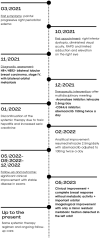Successful management of bilateral orbital metastases from invasive lobular breast cancer with abemaciclib and letrozole: a case report and literature review
- PMID: 38322413
- PMCID: PMC10845133
- DOI: 10.3389/fonc.2024.1286910
Successful management of bilateral orbital metastases from invasive lobular breast cancer with abemaciclib and letrozole: a case report and literature review
Abstract
Breast cancer is a significant global health concern, contributing to substantial morbidity and mortality among women. Hormone receptor-positive (HR+)/HER2-negative (HER2-) breast cancer constitutes a considerable proportion of cases, and significant advancements have been made in its management. CDK4/6 inhibitors (CDK4/6is) are a new targeted therapy that has demonstrated efficacy in adjuvant, advanced and metastatic settings. The propensity of lobular breast carcinomas for estrogen-rich sites, such as periocular tissues and orbital fat, may explain their tendency for orbital metastases. Current treatment strategies for these cases are predominantly palliative, and the prognosis remains poor. This article presents a unique case of a 51-year-old female with progressive right periorbital edema, pain, and limited ocular motility. An imaging work-up showed bilateral intra and extraconal orbital infiltration, which was biopsied. The histopathologic analysis disclosed mild chronic inflammatory infiltrate with thickened fibrous tissue and moderately differentiated lobular carcinoma cells, positive for GATA3 and CK7 markers, with 100% of tumor nuclei expressing estrogen receptors (ER+). A systemic evaluation showed a multicentric nodular formation in both breasts. Further diagnostic assessments unveiled an HR+/HER2- bilateral lobular breast carcinoma with synchronous bilateral orbital metastases. Systemic treatment was initiated with abemaciclib 150mg twice daily and letrozole 2.5mg once a day. However, this regimen was interrupted due to toxicity. After two weeks, treatment was resumed with a reduced abemaciclib dose (100mg twice daily) alongside letrozole, with a reasonable tolerance. Nearly two years after the initial diagnosis of inoperable metastatic cancer, the patient remains on the same systemic treatment regimen with no signs of invasive disease. This case report is the first of a patient presenting with bilateral orbital metastases from bilateral lobular breast cancer, showing an impressive and sustained response to a first-line treatment regimen combining abemaciclib and letrozole. A literature review on bilateral orbital metastases from breast cancer is also presented.
Keywords: CDK4/6 inhibitor; abemaciclib; breast cancer; case report; letrozole; metastases; orbit; review.
Copyright © 2024 Rodrigues Alves, Duarte, Ribeiro, Silva, Carvalho and Alpuim Costa.
Conflict of interest statement
DC has received honoraria from the Portuguese Navy, CUF Oncologia, RiberaSalud, and NTT DATA, and has served as a speaker, advisory board member, or has received research or education funding from AstraZeneca, CUF Oncologia, Daiichi Sankyo, Gilead, Hoffmann-La Roche, Merck KGaA, Merck Sharp & Dohme, Nestlé, Novartis, Pfizer, Nanobiotix, Puma Bio-technology Inc., Sanofi, Seagen Inc., and Uriage. DC is supported by two research grants: AstraZeneca Produtos Farmacêuticos LDA and Grupo José de Mello. The remaining authors declare that the research was conducted in the absence of any commercial or financial relationships that could be construed as a potential conflict of interest.
Figures




Similar articles
-
Periocular Breast Carcinoma Metastases: Predominant Origin From the Lobular Variant.Ophthalmic Plast Reconstr Surg. 2017 Sep/Oct;33(5):361-366. doi: 10.1097/IOP.0000000000000793. Ophthalmic Plast Reconstr Surg. 2017. PMID: 27749621
-
Case report: 18F-FES PET/CT predicted treatment responses of second-line and third-line CDK4/6 inhibitors after disease progression on first-line CDK4/6 inhibitor in a HR+/HER2- metastatic breast cancer patient.Front Oncol. 2022 Dec 23;12:1095779. doi: 10.3389/fonc.2022.1095779. eCollection 2022. Front Oncol. 2022. PMID: 36620595 Free PMC article.
-
Cost Effectiveness of CDK4/6 Inhibitors in the First-Line Treatment of HR+/HER2- Metastatic Breast Cancer in Postmenopausal Women in the USA.Pharmacoeconomics. 2023 Jun;41(6):709-718. doi: 10.1007/s40273-023-01245-y. Epub 2023 Mar 15. Pharmacoeconomics. 2023. PMID: 36920662
-
Pharmacoeconomic evaluations of CDK4/6 inhibitors plus endocrine therapy for advanced hormone receptor-positive (HR+) and human epidermal growth factor receptor-2 negative (HER2-) breast cancer: a systematic review.Ann Transl Med. 2022 Feb;10(4):233. doi: 10.21037/atm-21-5110. Ann Transl Med. 2022. PMID: 35280368 Free PMC article. Review.
-
A narrative review of the clinical development of CDK4/6 inhibitor abemaciclib in breast cancer.Transl Breast Cancer Res. 2022 Jan 31;3:4. doi: 10.21037/tbcr-21-36. eCollection 2022. Transl Breast Cancer Res. 2022. PMID: 38751545 Free PMC article. Review.
Cited by
-
Case report: Near-complete response to neratinib-based treatment in HR-positive HER2-amplified metastatic breast cancer refractory to trastuzumab deruxtecan.Front Oncol. 2025 Jan 21;14:1484750. doi: 10.3389/fonc.2024.1484750. eCollection 2024. Front Oncol. 2025. PMID: 39931207 Free PMC article.
References
-
- Blows FM, Driver KE, Schmidt MK, Broeks A, van Leeuwen FE, Wesseling J, et al. . Subtyping of breast cancer by immunohistochemistry to investigate a relationship between subtype and short and long term survival: A collaborative analysis of data for 10,159 cases from 12 studies. PloS Med (2010) 7(5):e1000279. doi: 10.1371/journal.pmed.1000279 - DOI - PMC - PubMed
-
- NIH SEER Program . Cancer stat facts: female breast cancer subtypes. 2022. Cancer stat facts: female breast cancer subtypes. Available at: https://seer.cancer.gov/statfacts/html/breast-subtypes.html (Accessed 1st August 2023).
Publication types
LinkOut - more resources
Full Text Sources
Research Materials
Miscellaneous

